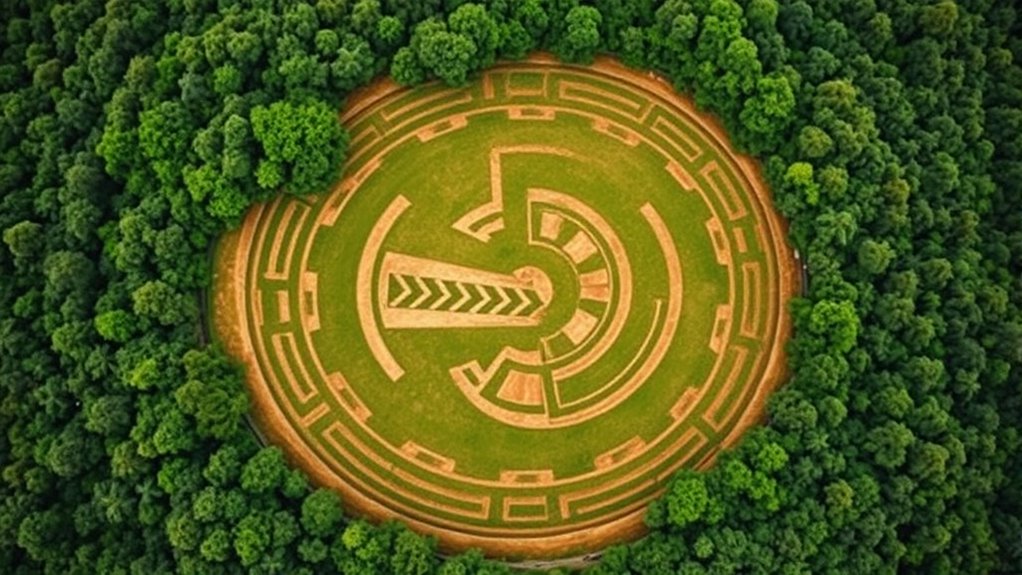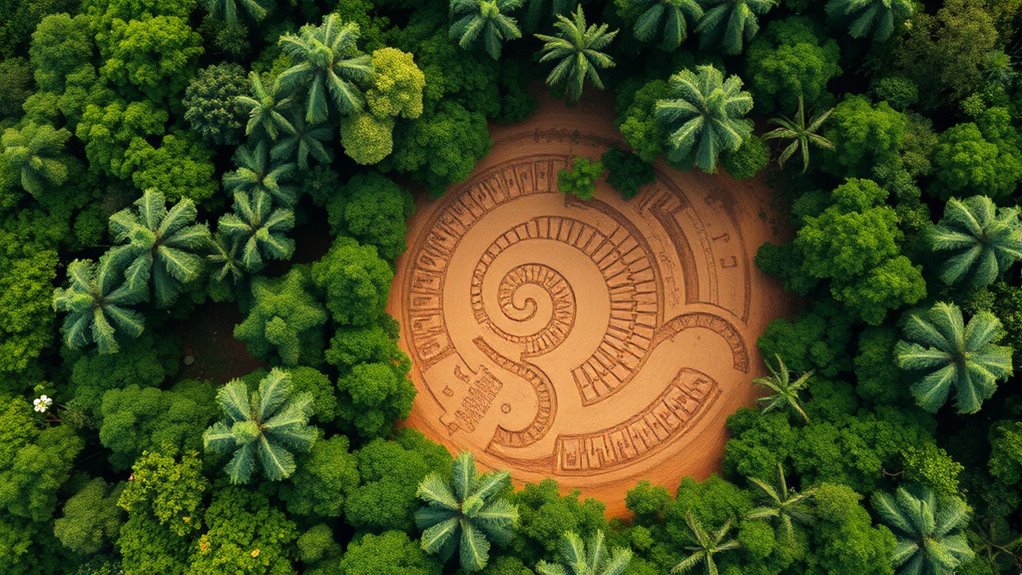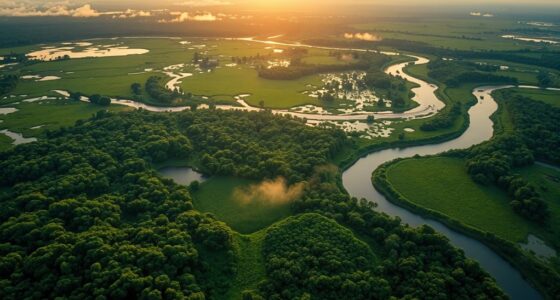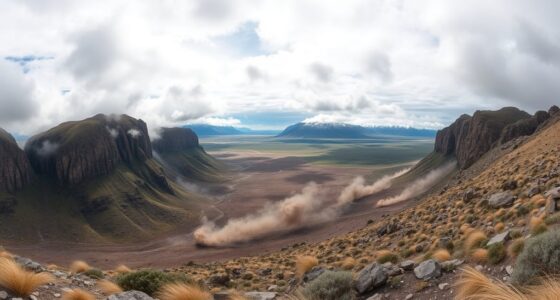Hidden deep within the Amazon rainforest, ancient geoglyphs are older than the famous Nazca Lines by thousands of years. These earthworks show early societies sculpting the landscape with sophisticated knowledge long before known civilizations like Nazca arose. Their purpose might have been navigation, spiritual, or territorial. The discovery of these geoglyphs challenges what you thought about early South American cultures, and if you keep exploring, you’ll uncover even more fascinating secrets about this mysterious region.
Key Takeaways
- Amazonian geoglyphs are older than the Nazca Lines, dating back thousands of years earlier.
- They are hidden within dense rainforest and only recently detected through remote sensing and aerial imagery.
- These earthworks served as navigation landmarks and possibly held spiritual or ceremonial significance.
- Their discovery challenges previous beliefs about early South American societies’ complexity and environmental knowledge.
- The hidden geoglyphs reveal a sophisticated cultural history long concealed beneath the jungle canopy.

While the Nazca Lines are famous for their intricate designs and age, recent discoveries reveal that geoglyphs in other regions are actually older. Hidden deep within the Amazon rainforest, these ancient geoglyphs challenge what you thought you knew about early human ingenuity and their relationship with the land. Unlike the well-known Nazca Lines, which stretch across desert plains, these Amazonian geoglyphs are carved into the earth’s surface amid dense jungle, making them difficult to detect until recent technological advances. What’s truly fascinating is that these markings date back thousands of years earlier, suggesting that early societies in South America possessed sophisticated knowledge of their environment long before the Nazca civilization flourished.
You might wonder why these geoglyphs were created and what they meant to their creators. Evidence suggests that they served crucial roles in ancient navigation, guiding travelers through the treacherous, often confusing rainforest landscape. These earthworks could have acted as landmarks, helping communities find their way across dense terrain, much like celestial navigation or star maps in other ancient cultures. Their size and placement imply they weren’t just random markings but deliberate signals to others familiar with their significance. This use of the earth as a navigational tool underscores a remarkable understanding of both the environment and the importance of communal pathways. Additionally, the construction of these geoglyphs would have required sophisticated engineering, indicating a high level of social organization and environmental knowledge among their creators.
Ancient geoglyphs served as vital landmarks guiding rainforest travelers.
Beyond navigation, these geoglyphs were likely imbued with cultural symbolism. Their shapes and locations might have represented spiritual beliefs, territorial boundaries, or social hierarchies. You can think of them as visual language—an expression of collective identity and worldview. Some scholars believe that these earthworks marked sacred sites or served as ceremonial centers, reinforcing social cohesion and spiritual beliefs. In this way, the geoglyphs weren’t just practical tools but also powerful symbols that connected people to their ancestors, land, and spiritual worlds. Their enduring presence, even after centuries of jungle growth, shows how deeply intertwined these markings were with the cultural fabric of their creators.
What makes these discoveries so compelling is how they rewrite history, showing that early Amazonian societies possessed complex social and environmental knowledge. They demonstrate that humans in this region didn’t merely survive but actively shaped their surroundings with purpose and symbolism. You now see these ancient geoglyphs as more than just mysterious ground drawings; they are testimonies to a rich, sophisticated culture that used earthworks for practical and spiritual reasons. Their age and purpose reveal a nuanced understanding of ancient navigation and cultural symbolism, challenging assumptions that only coastal or desert civilizations developed such complex earthworks. Instead, they prove that the Amazon was a hub of ingenuity, with geoglyphs older than Nazca hiding silently in the lush greenery, waiting to tell their story.
Frequently Asked Questions
How Do Geoglyphs Survive Environmental Changes Over Millennia?
You might wonder how geoglyphs survive environmental changes over millennia. Soil preservation plays a key role, as stable soils protect these structures from erosion. Additionally, climate impact varies; in some regions, stable microclimates help preserve the geoglyphs, while in others, changes may cause deterioration. By understanding these factors, you see how certain geoglyphs endure despite the passage of time and environmental shifts.
What Tools Did Ancient Peoples Use to Create These Geoglyphs?
You might wonder what ancient peoples used to create these massive geoglyphs. They relied on simple yet effective construction techniques, using ancient tools like sticks, stones, and digging tools to shape the earth. These early creators carefully planned their designs, clearing vegetation and shaping the ground with precision. Their knowledge of the land and clever use of available tools allowed them to produce enduring geoglyphs that have survived thousands of years.
Are There Any Known Purposes or Meanings Behind the Shapes?
You might wonder about the symbolic meanings or ritual purposes behind these ancient shapes. While definitive answers are scarce, many believe they served spiritual or ceremonial functions, possibly related to hunting, astronomy, or territorial markers. The intricate designs suggest they held cultural significance, helping communities connect with their beliefs or ancestors. These geoglyphs likely played a crucial role in conveying sacred stories or guiding ritual activities.
How Do Geoglyphs Influence Local Ecosystems Today?
You might think geoglyphs are just ancient artworks, but surprisingly, they still influence local ecosystems today. While they don’t actively shape the environment, their agricultural impact and cultural significance preserve biodiversity and traditional practices. These massive designs remind us that human history and nature intertwine, encouraging respect for cultural heritage. So, in a way, geoglyphs quietly protect ecosystems, proving sometimes art truly has ecological power.
Could Similar Geoglyphs Exist in Unexplored Regions of the Amazon?
You might wonder if Amazonian mysteries hide hidden landscapes similar to other ancient geoglyphs. It’s possible that undiscovered geoglyphs exist in the dense, unexplored regions of the Amazon, revealing clues about past civilizations. These hidden landscapes could reshape our understanding of history and human activity in the rainforest. Advances in technology, like drone surveys, increase your chances of uncovering such ancient secrets, making the search for these mysterious formations exciting and promising.
Conclusion
As you uncover these ancient secrets hidden in the lush Amazon, it’s like peeling back a rainforest curtain to reveal a forgotten treasure map. These geoglyphs, older than Nazca, whisper stories of civilization long past, etched into the earth like silent sentinels guarding history. Their mysterious shapes dance beneath the canopy, reminding you that Earth’s hidden stories are waiting to be rediscovered, like stars hidden in a cloudy sky, shining quietly, longing to be seen.










